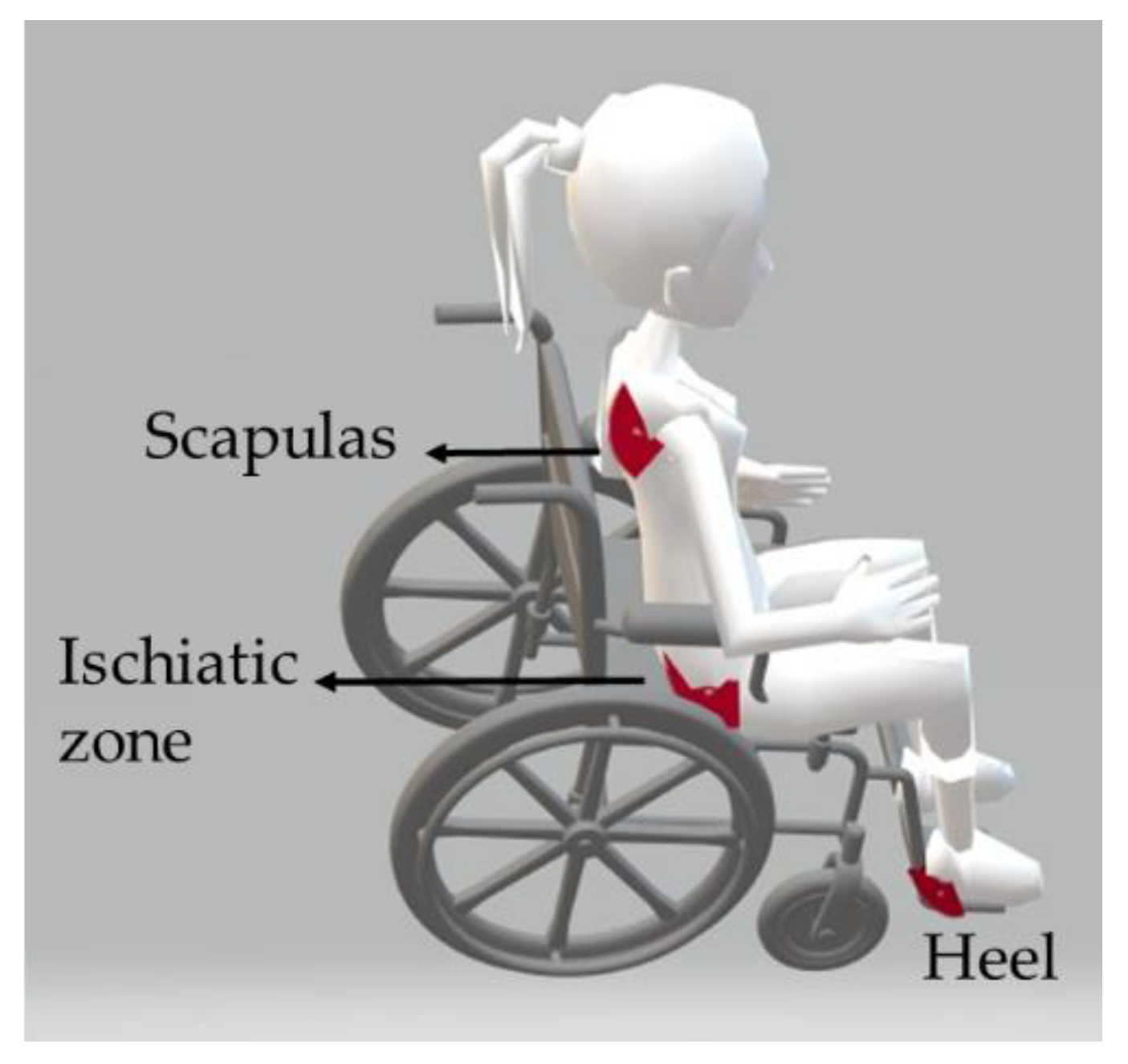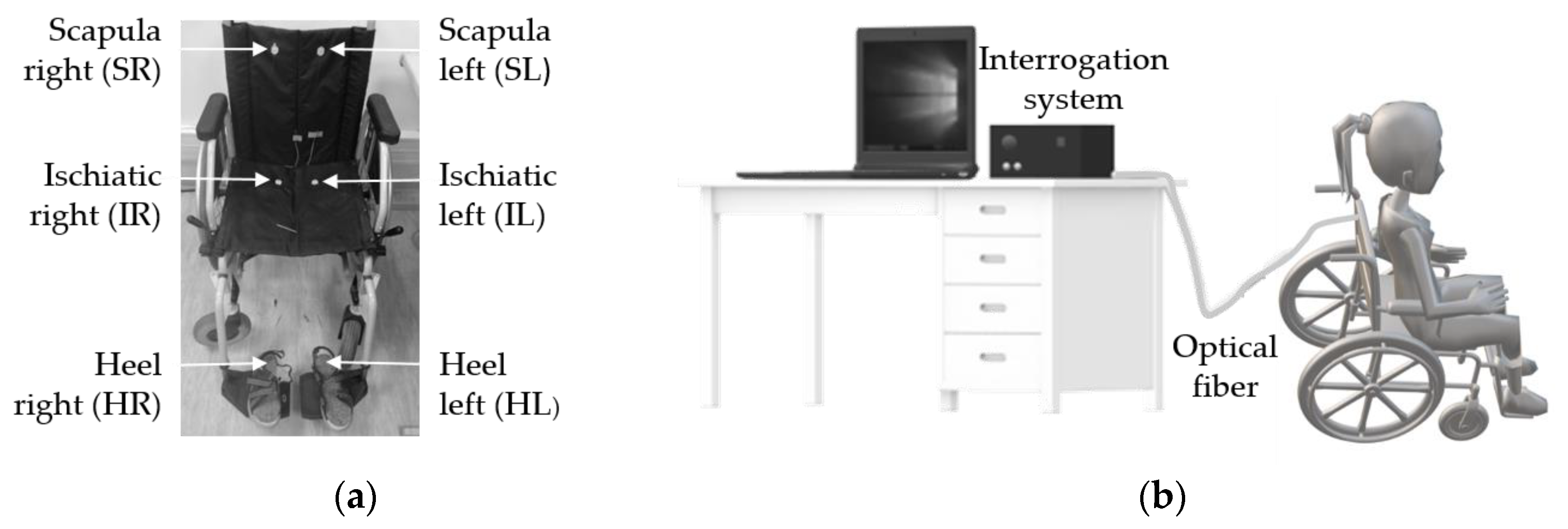Wheelchair Pressure Ulcer Prevention Using FBG Based Sensing Devices
Abstract
1. Introduction
2. Fiber Bragg Grating Sensing Principle
3. Sensing System Preparation and Calibration
4. Wheelchair Pressure Monitoring
4.1. Protocol and Implementation
4.2. Results and Discussion
5. Conclusions
Author Contributions
Funding
Acknowledgments
Conflicts of Interest
References
- Verbunt, M.; Bartneck, C. Sensing senses: Tactile feedback for the prevention of decubitus ulcers. Appl. Psychophysiol. Biofeedback 2010, 35, 243–250. [Google Scholar] [CrossRef] [PubMed]
- Gordon, M.; Gottschlich, M.; Helvig, E.; Marvin, J.; Richard, R. Review of evidenced-based practice for the prevention of pressure sores in burn patients. J. Burn Care Res. 2004, 25, 388–410. [Google Scholar] [CrossRef] [PubMed]
- Banks, M.; Graves, N.; Bauer, J.; Ash, S. The costs arising from pressure ulcers attributable to malnutrition. Clin. Nutr. 2010, 29, 180–186. [Google Scholar] [CrossRef] [PubMed]
- Brem, H.; Maggi, J.; Nierman, D.; Rolnitzky, L.; Bell, D.; Rennert, R.; Michael, M.; Alan, M.; Courtney, N.; Bruce, V. High cost of stage IV pressure ulcers. Am. J. Surg. 2010, 200, 473–477. [Google Scholar] [CrossRef] [PubMed]
- Dai, R.; Sonenblum, S.; Sprigle, S. A robust wheelchair pressure relief monitoring system. In Proceedings of the 2012 Annual International Conference of the IEEE Engineering in Medicine and Biology Society, San Diego, CA, USA, 28 August–1 September 2012. [Google Scholar]
- Brienza, D.; Kelsey, S.; Karg, P.; Allegretti, A.; Olson, M.; Schmeler, M.; Zanca, J.; Geyer, M.; Kusturiss, M.; Holm, M. A randomized clinical trial on preventing pressure ulcers with wheelchair seat cushions. J. Am. Geriatr. Soc. 2010, 58, 2308–2314. [Google Scholar] [CrossRef] [PubMed]
- Houwing, R.; Rozendaal, M.; Wouters-Wesseling, W.; Beulens, J.; Buskens, E.; Haalboom, J. A randomised, double-blind assessment of the effect of nutritional supplementation on the prevention of pressure ulcers in hip-fracture patients. Clin. Nutr. 2003, 22, 401–405. [Google Scholar] [CrossRef]
- Bourdel-Marchasson, I.; Barateau, M.; Rondeau, V.; Dequae-Merchadou, L.; Salles-Montaudon, N.; Emeriau, J.; Manciet, G.; Dartigues, J. A multi-center trial of the effects of oral nutritional supplementation in critically ill older inpatients. Nutrition 2000, 16, 1–5. [Google Scholar] [CrossRef]
- Defloor, T.; Bacquer, D.; Grypdonck, M. The effect of various combinations of turning and pressure reducing devices on the incidence of pressure ulcers. Int. J. Nurs. Stud. 2005, 42, 37–46. [Google Scholar] [CrossRef]
- Young, T. The 30 degree tilt position vs the 90 degree lateral and supine positions in reducing the incidence of non-blanching erythema in a hospital inpatient population: A randomised controlled trial. J. Tissue Viability 2004, 14, 88–96. [Google Scholar] [CrossRef]
- Shirreffs, B.; Ferguson-Pell, M. Remote monitoring of sitting behavior of people with spinal cord injury. J. Rehabil. Res. Dev. 2002, 39, 513–520. [Google Scholar]
- Chenu, O.; Vuillerme, N.; Bucki, M.; Diot, B.; Cannard, Y. TexiCare: An innovative embedded device for pressure ulcer prevention. Preliminary results with a paraplegic volunteer. J. Tissue Viability 2013, 22, 83–90. [Google Scholar] [CrossRef] [PubMed]
- Sonenblum, S.; Stephen, H.; James, S. Everyday sitting behavior of full-time wheelchair users. J. Rehabil. Res. Dev. 2016, 53, 585–598. [Google Scholar] [CrossRef] [PubMed]
- Sonenblum, S.; Vonk, T.; Janssen, T.; Sprigle, S. Effects of wheelchair cushions and pressure relief maneuvers on ischial interface pressure and blood flow in people with spinal cord injury. Arch. Phys. Med. Rehabil. 2014, 95, 1350–1357. [Google Scholar] [CrossRef] [PubMed]
- Ma, C.; Li, W.; Gravina, R.; Fortino, G. Activity recognition and monitoring for smart wheelchair users. In Proceedings of the 2016 IEEE 20th International Conference on Computer Supported Cooperative Work in Design (CSCWD), Nanchang, China, 4–6 May 2016. [Google Scholar]
- Arias, S.; Cardiel, E.; Garay, L.; Tovar, B.; Pla, M.; Rogeli, P. A pressure distribution measurement system for supporting areas of wheelchair users. In Proceedings of the 35th Annual International Conference of the IEEE Engineering in Medicine and Biology Society (EMBC), Osaka, Japan, 3–7 July 2013. [Google Scholar]
- Domingues, M.; Tavares, C.; Alberto, N.; Radwan, A.; André, P.; Antunes, P. High rate dynamic monitoring with Fabry–Perot interferometric sensors: An alternative interrogation technique targeting biomedical applications. Sensors 2019, 19, 4744. [Google Scholar] [CrossRef]
- Antunes, P.; Leitão, C.; Rodrigues, H.; Travanca, R.; Lemos-Pinto, J.; Costa, A.; Varum, H.; André, P. Optical fiber Bragg grating based accelerometers and applications. In Accelerometers: Principles, Structure and Applications; Nova Publishers: New York, NY, USA, 2013. [Google Scholar]
- Tavares, C.; Domingues, M.F.; Frizera-Neto, A.; Leite, T.; Leitão, C.; Alberto, N.; Marques, C.; Radwan, A.; Rocon, E.; André, P.; et al. Gait shear and plantar pressure monitoring: A non-invasive OFS based solution for e-Health architectures. Sensors 2018, 18, 1334. [Google Scholar] [CrossRef]
- Carvalho, L.; Alberto, N.; Gomes, P.; Nogueira, R.; Lemos-Pinto, J.; Fernandes, M. In the trail of a new bio-sensor for measuring strain in bone: Osteoblastic biocompatibility. Biosens. Bioelectron. 2011, 26, 4046–4052. [Google Scholar] [CrossRef]
- Antunes, P.; Varum, H.; André, P. Optical FBG sensors for static structural health monitoring. Procedia Eng. 2011, 14, 1564–1571. [Google Scholar] [CrossRef][Green Version]
- Domingues, M.; Alberto, N.; Leitão, C.; Tavares, C.; Lima, E.; Radwan, A.; Sucasas, V.; Rodriguez, J.; André, P.; Antunes, P. Insole optical fiber sensor architecture for remote gait analysis-an eHealth Solution. IEEE Internet Things J. 2019, 6, 207–214. [Google Scholar] [CrossRef]
- Ferreira, L.; Antunes, P.; Domingues, F.; Silva, P.; André, P. Monitoring of sea bed level changes in nearshore regions using fiber optic sensors. Measurement 2012, 45, 1527–1533. [Google Scholar] [CrossRef]
- Alberto, N.; Bilro, L.; Antunes, P.; Leitão, C.; Lima, H.; André, P.; Nogueira, R.; Pinto, J. Optical fiber technology for eHealthcare. In Handbook of Research on ICTs and Management Systems for Improving Efficiency in Healthcare and Social Care; Cruz-Cunha, M., Miranda, I., Gonçalves, P., Eds.; Medical Information Science Reference; IGI global: Hershey, PA, USA, 2013; pp. 180–200. [Google Scholar]
- Domingues, M.; Tavares, C.; Leitão, C.; Neto, A.; Alberto, N.; Marques, C.; Radwan, A.; Rodriguez, J.; Postolache, O.; Rocon, E.; et al. Insole optical fiber Bragg grating sensors network for dynamic vertical force monitoring. J. Biomed. Opt. 2017, 22, 091507. [Google Scholar] [CrossRef]
- Cretikos, M.; Bellomo, R.; Hillman, K.; Chen, J.; Finfer, S.; Flabouris, A. Respiratory rate: The neglected vital sign. Med. J. Aust. 2008, 188, 657–659. [Google Scholar] [CrossRef] [PubMed]









| Cell | Sensitivity Coefficient (pm/kPa) |
|---|---|
| Right heel (HR) | 9.6 ± 0.1 |
| Left heel (HL) | 10.2 ± 0.2 |
| Right scapula (SR) | 18.2 ± 0.2 |
| Left scapula (SL) | 17.8 ± 0.3 |
| Right ischiatic (IR) | 17.9 ± 0.3 |
| Left ischiatic (IL) | 18.5 ± 0.2 |
© 2019 by the authors. Licensee MDPI, Basel, Switzerland. This article is an open access article distributed under the terms and conditions of the Creative Commons Attribution (CC BY) license (http://creativecommons.org/licenses/by/4.0/).
Share and Cite
Tavares, C.; Domingues, M.F.; Paixão, T.; Alberto, N.; Silva, H.; Antunes, P. Wheelchair Pressure Ulcer Prevention Using FBG Based Sensing Devices. Sensors 2020, 20, 212. https://doi.org/10.3390/s20010212
Tavares C, Domingues MF, Paixão T, Alberto N, Silva H, Antunes P. Wheelchair Pressure Ulcer Prevention Using FBG Based Sensing Devices. Sensors. 2020; 20(1):212. https://doi.org/10.3390/s20010212
Chicago/Turabian StyleTavares, Cátia, M. Fátima Domingues, Tiago Paixão, Nélia Alberto, Hugo Silva, and Paulo Antunes. 2020. "Wheelchair Pressure Ulcer Prevention Using FBG Based Sensing Devices" Sensors 20, no. 1: 212. https://doi.org/10.3390/s20010212
APA StyleTavares, C., Domingues, M. F., Paixão, T., Alberto, N., Silva, H., & Antunes, P. (2020). Wheelchair Pressure Ulcer Prevention Using FBG Based Sensing Devices. Sensors, 20(1), 212. https://doi.org/10.3390/s20010212









